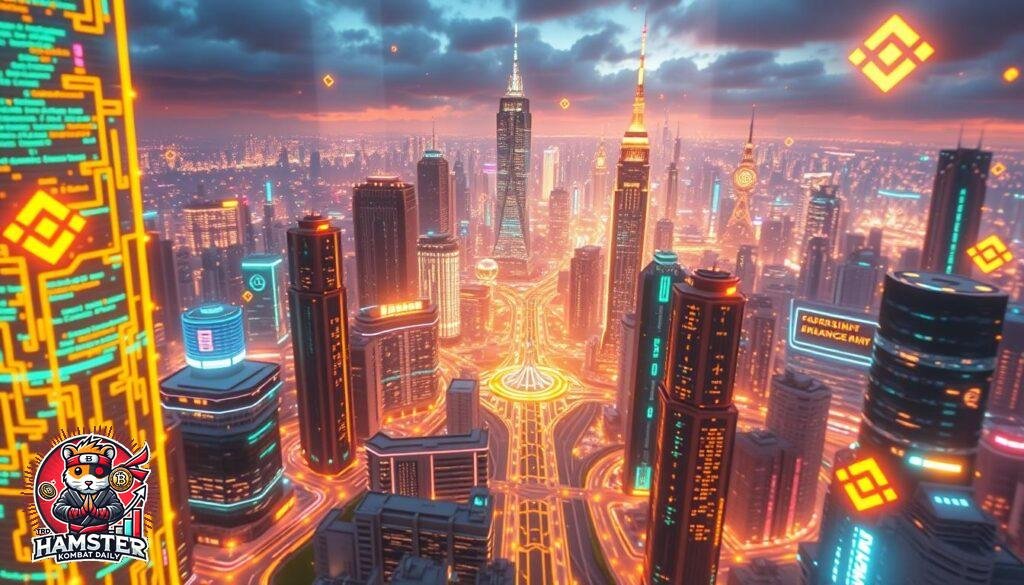This guide will take you through the Binance smart contracts platform. You’ll learn from the basics to how it works in real life. You’ll see how Binance is different from other exchanges like PancakeSwap.
Find out how Binance Smart Chain grew from Binance Chain. Learn about its features and how it helps create smart contracts and apps. This guide uses data from “Mastering Crypto Investment” and Binance’s stats as of August 2024.
Understanding the Binance Smart Contracts Platform
The Binance Smart Contracts Platform is key in the world of finance. It has a strong ecosystem and works in many ways. This part explains what makes it special and how it fits into the blockchain world.
What is Binance Smart Chain?
Binance Smart Chain (BSC) is a blockchain made by Binance. It lets people make and run smart contracts. It started in 2019 and works with a proof-of-stake model. This makes it fast and cheap.
It also works with Ethereum’s apps. This makes it popular with developers and users. They like its speed, security, and low cost.
Key Features and Advantages
- Speed and Efficiency: BSC is very fast, with transactions in just three seconds.
- EVM Compatibility: It works well with Ethereum apps, making it easy to use.
- Cross-Chain Transfers: It lets you move assets between chains. This is a big plus.
- Security: It uses tools like Certik Skynet to keep smart contracts safe.
- Significant TVL: By August 2024, it’s the 4th biggest blockchain by value. This shows it’s growing fast.
Comparison with Other Blockchain Platforms
Binance Smart Chain is cheaper and faster than Ethereum. This is great for developers who want to save money but still have good performance. It also works well with Ethereum apps, which is a big plus.
BSC also has cool tools for tracking big users and keeping things safe. This helps keep the system trustworthy. It’s used in many cool areas like DeFi and NFTs, showing it’s very flexible.
How to Develop and Deploy on Binance Smart Contracts Platform
Starting with Binance Smart Contracts Platform is exciting. You have many tools and resources to help. We’ll show you the key tools, a deployment guide, and best practices for using Solidity.
Tools and Resources for Developers
First, pick the right tools and resources. A good IDE is key for writing and testing smart contracts. Remix is a popular online IDE with features for Solidity.
The Binance smart contracts SDK has pre-built libraries to help you. It’s also important to audit your contracts for security. Solidity, the main language, has lots of documentation and examples to help you.
Step-by-Step Deployment Guide

- Use Remix or another IDE to write your contract in Solidity.
- Check your contract for errors.
- Connect to Binance Smart Chain with MetaMask or another wallet.
- Test your contract on the testnet first.
- Then, deploy it on the mainnet.
Best Practices for Smart Contract Development
Following best practices is crucial. Always audit your contracts for security. Also, use gas wisely to save money.
Use well-known IDEs and SDKs to improve your work. Write code that’s easy to update. Keep detailed notes on your contracts for audits and teamwork.
By following these tips, using the right tools, and a clear guide, you can make the most of Binance Smart Contracts. You’ll help grow its ecosystem.
Conclusion
The Binance smart contracts platform is a big deal in the blockchain world. It makes it easy to create apps that work on their own. It also keeps things safe and is always getting better.
In 2024, new crypto projects popped up, focusing on real use, not just talk. HealthyCoin and ClipFinance showed what blockchain can do. The Binance Smart Chain is key, with low costs and fast work.
Looking to the future, updates and rules will help the Binance world grow. Just like Bitcoin and Ethereum, blockchain is always changing. By understanding and joining in, you can help make the future bright for Binance.
